A research that brings together sculpture, architecture and painting between fragility and lightness. It is that of Valdi Spagnulo: born in Ceglie Messapica (Brindisi) in 1961, he spent his early childhood in Grottaglie, a town known for the production of artisanal and artistic ceramics, frequenting the creative and intellectual environment of the Apulian area and beyond from a very young age, thanks to his father, the artist Osvaldo Spagnulo. In 1973 with his family he moved to Milan, opening up to the European sphere with trips to France, Germany, and Switzerland, and beginning artistic studies first at the Liceo Artistico di Brera, then at the Faculty of Architecture of the Milan Polytechnic, where he graduated in 1984. At the same time, the beginning of the 1980s marked his debut as a painter and the start of a dense exhibition activity, including long collaborations first with Giovanni Fumagalli’s Galleria delle Ore, then with Patrizia Serra’s Spaziotemporaneo, as well as numerous other solo and group shows at other exhibition spaces. In 2001 he received the first Painting Prize of the Accademia di San Luca in Rome. He lives and works mainly in Milan and is a lecturer for the chair of Painting at the Academy of Fine Arts in Florence.

Valdi, art comes from the blood, which sometimes can lead to a deep hatred of it or at its exact opposite can open up a visceral love. I wanted to ask you to tell about your childhood and the way your interest in art manifested, the episodes, people, encounters and objects that propitiated this encounter...
Dear Gabriel, my contact with the world of visual arts really goes back to the period of my childhood. Unfortunately or fortunately, to this day although I have passed the threshold of sixty, I do not know whether to consider myself lucky or damned in having been born a child of art. My father was Osvaldo Spagnulo (known to most as “the fire painter”), his strong as well as unmanageable personality and his complex as well as original pictorial production has certainly created joys and sorrows in my complex existence. An existence that, from the tender age of five, saw me directly participating attached to the flaps of his flamboyant studio attire while he was painting, while he was planning exhibitions, while he was sending the works in the crates to the awards, to the Quadrennials... In short, participating as I was growing up... and the smell of oil pigments, glazes, powders, gasoline, turpentine and various solvents... the mixtures he created for combustions... all those toxicities that marked his art have been part of my life from the beginning. The counterbalance to the elaborative phase, which as you can imagine had a determining fascination of wanting to make, was the world of culture, critics, artists (painters, sculptors, photographers, poets, writers, musicians...), gallery owners, museum directors, models, ceramists... in short, all that entourage that can be part of this world. Yes because it is a real damn world we are talking about. Of something that damnably, dramatically, energetically gets inside you from the peculiarities to the adversities of the lives of those who come alongside you ... because, it is with all this colorful complexity that you will find yourself living to survive. At least that was the case for me. For example, I remember with pleasure a meeting in the early 1970s in Taranto, I was about ten years old, in a beautiful apartment overlooking the seafront at the home of the artist Michele Perfetti (Visual Poetry), who wrote at that time a text for the catalog of an exhibition of Dad’s ... almost 45 years later I met Perfetti’s son in Ferrara, an immense emotion. Or the exhibitions at Circolo Italsider in Taranto where as a child I met some of those who would become the masters of today (Pino Spagnulo, Pietro Coletta, Nicola Carrino...). Then the sea with its secret places along the cliffs, where we went to swim but, also to grow old in the depths of the water, as well as with the combustions the ceramics that Dad made as a parallel production to the paintings. Not to mention the various visits to the workshops of Grottaglie (town where we lived), of the potters great artisans of traditional folk production and that of the experimenters... all great friends and admirers of Osvaldo. Yes, a figure encumbered my father but, at the same time he allowed me to experience as a child an environment, a colorful social humus. Then in 1973 the big leap ... from Grottaglie to Milan, from a warm but then very provincial reality, to the Milan of the industrial triangle ... I was just 12 years old and I found myself from a place of about 25,000 souls in a metropolis that then, including the hinterland, had almost two million inhabitants and was the Italian engine with the relationship of the rest of Europe and the world. What was soon to become in the chronicles the Milan of the great political season of the post-68 protest, of organized crime, of the BR... all factors that had on my growth a strong component of cultural, political revenge, also linked to the visual arts... Attendance of the various cult circles in Brera, bar Jamaica, the Jazz 2 and many others until late at night despite my young teenage age but. Osvaldo was there with me watching over that frenetic lightheartedness that concealed the torment of wanting to do his own thing. In all of this at the dissimilarity of a seemingly irregular life a great role was played by my mother Margherita who, with her artful rule of life, held as a woman the logical strings of so much unruliness. Behold, this was my initiation into the world of art or rather visual arts for the most part, which had deep loves for poetry and music, I remember with emotion and particular pleasure the escape from home to participate in 1974 in the Re Nudo Pop Gathering at Parco Lambro in Milan where the way of freedom of thought and action with PFM, Area, Battiato, Sorrenti, Stormy Six, etc. ... and Carlo Ramous’ exhibitions in Piazza del Duomo with environmental works, those at the Galleria del Milione, Dorfles and Munari, Dario Fo and the Palazzina Liberty... in short, involved, alienated and fascinated by the ferment of ideas and the freedom of making... making Art.
What was your course of study and what was your relationship with school?
Dear Gabriele I’ll tell you right away that my relationship with school at all levels was from the beginning to say the least conflicting. I did not like school, I did not feel like going there, and I had teachers and professors who in most cases did not stimulate and intrigue me as much as forays from the outside world were capable of doing. Let’s be clear, I have also had teachers who have been points of reference and reflection, but I have perhaps better understood and recognized them in this role in retrospect. In the field of visual arts I had my first approach in middle school done in Grottaglie where in the subjects of Art Education and Technical Education we often worked with ceramics given the nature and origins of this Apulian town. Then the studies at the Liceo Artistico I of Brera in Milan in which the presence of some important artists, albeit in progress at the time (Mauro Staccioli, Mimmo Paladino...) played a certain role in bringing me closer and closer to this world. Last and not least, the choice not to attend the Academy of Fine Arts in Brera but, after a certain exhortation from my parents, to continue my studies and not interrupt them in order to propose myself in the world of work, led me to my great satisfaction to attend the Faculty of Architecture at the Milan Polytechnic to thus graduate in 1984 with honors (thanks also to my traveling companions Mario and Vincenzo, egregious Architects and fraternal friends), who always knew how to make me believe that I could make it and great. A profession that I practiced sporadically and then put my attention to teaching to give more outlet and interaction to freelancing first as a painter and later as a sculptor.
Has your background in architecture left a trace in your work?
Gabriele this question of yours is practically the whole pivot of my research in the field of visual arts, and it will always be so even when I decide to work with other expressive media that can interact with those I have so far employed. Practically taking away a brief interlude during my studies and shortly after graduation I by choice did not want to practice as an architect as it was envisaged for me in the design/professional field ... in short, I did not feel like being a bagman or an accountant of architecture. As I said, the visual arts involved me more but, at the same time, studies in architecture certainly contributed to some of the linguistic-formal-compositional choices in my works both as a painter first and as a sculptor later. First of all, I have always been interested in the spatial organization and at the same time a certain sense of instability, precariousness of the work of some of the great masters of the avant-garde, MaleviÄ, Mondrian, Delaunay, Klee, Kandinsckij and those of the more contemporaries Fontana, Burri, Castellani, Bonalumi, Staccioli, Carrino, Nevelson not to mention the architects Tatlin, Le Corbusier, Piano, Gehry, Calatrava, Hadid... References of study and knowledge for a research, mine, of which I will not describe here... there are various writings on my work that exhaustively explicate the poetics of my work. One emphasis, if I have to do so, is the visual/expressive search for the instability of a continuous obsessive fragility of the work, a certain precariousness of balance, an overbearing and obsessive absence of volume for a visual permeability of the form... Space as I have repeatedly stated is contained in it. So I love to start from the architectural component to question it, in becoming with the unstable precariousness that, challenges impossible balances of visual and static stability...The precariousness of human existence. I always design my works with an architect’s flair, almost never on paper...in my mind I do and I realize them with the principle of work in progress with the principle that error and chance will give me the right strength to leave them there...balanced in space and time.



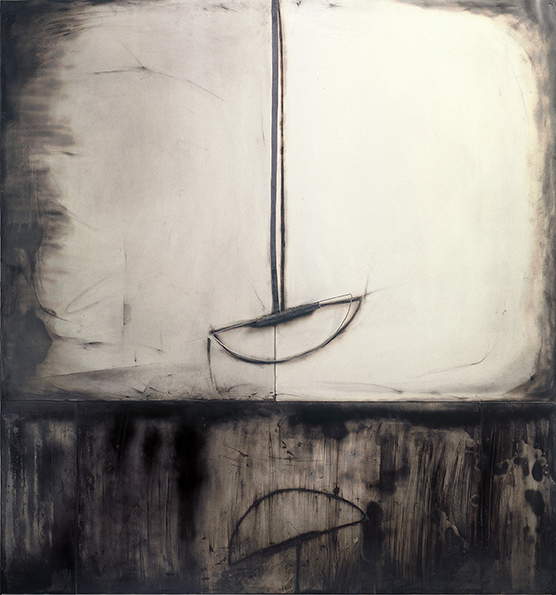


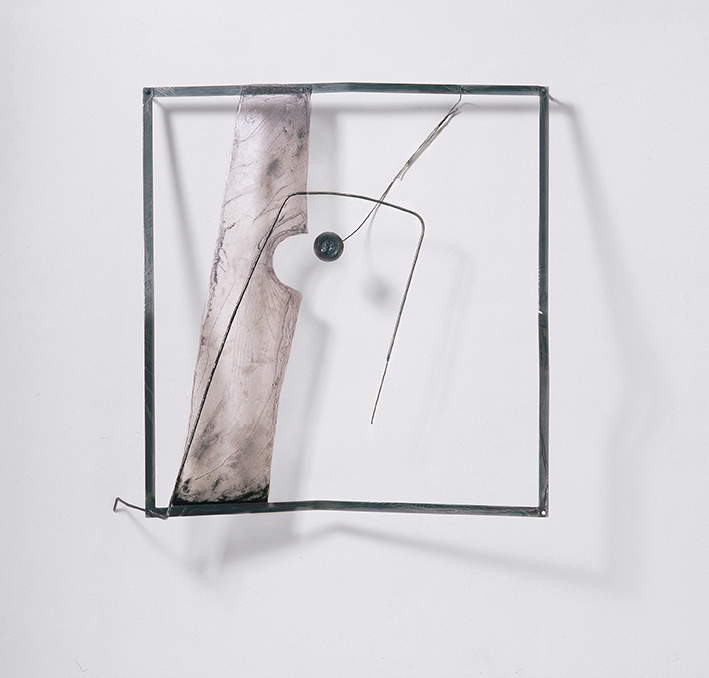
Valdi, do you think the case exists?
Dear Gabriele in an interview you gave me about three years ago for Parole d’Artista in reference to the contingency of happenings in the creative process I concluded by saying, “Even chance becomes a source of unpredictable suggestions”... Yes, so “art” happens"! Yes, chance exists!... And as far as I am concerned in my creative-operational proceeding I do not demonize it on the contrary. I often give it free rein. This has been for me the lesson that from an early age I have grasped in the work of my father Osvaldo, but above all I have found it in the lesson of a series of artists who with their work and their proceeding have taught us that planning also makes use of chance... I’m thinking for example of the work of Vedova, Pollok, Cy Twombly, Fontana, Burri, and of the latter in this regard I remember a beautiful interview from the Teche RAI I think signed by Franco Simongini, My art cannot be explained, master Burri speaks. Here is this just to mention one to then move on to the sculptors who worked on the precariousness of form by assembling objects and artifacts... Colla, Melotti, the Dada and Surrealists with the Ready-Mades or Schwitters’ Merzbau... in short if we were to disregard chance much of contemporary art and not only it would not have originated... and when I speak of art I am referring to the many forms and guises through it manifests itself and not only of the visual arts. Think of the role that chance has been able to play in the synaesthetic art form...well, in my opinion a lot! To conclude however I find it appropriate to mention Bruno Munari, Gillo Dorfles, Filiberto Menna, Jole De Sanna who some guidelines have given in this regard with their critical contribution. All these factors have oriented me towards a work as already said work in progress and free from projects that create peremptory rules... rules are needed and it is right to know them but, even disregarding them has its reason... the case is one of them.
In your opinion, is the artist, through the daily practice of his work, able to organize and make manifest, visible and tangible plots of energies/forces?
Dear Gabriel, as you well know I do not like the definition of “artist,” far too overused and often out of proportion. However, yes! In my opinion, those who engage in expressive practices of the visual and non-visual arts, just like an athlete, daily have to exercise a “training” ... a kind of constant, periodic practice of doing, of thinking. So the different forms from representation to expression manifest their own plots. I think of Pasolini, Carmelo Bene, Gassman... to Vedova, Pollock, Rothko, Picasso... to Queen, Deep Purple, Area... and on and on it goes. From the most energetic to the most “thoughtful” and quiet in appearance... Morandi, Casorati, Ferroni...each of them with their work has conveyed to us a thought, a language...their own “plot” with forces and energies that can meet or clash with our sensibility... “Nothing is created, nothing is destroyed, everything is transformed.” Burri, Fontana, Tapies, Stratos, Page...the synaesthetic... Studio Azzurro, Cage. In short, in my humble opinion, daily practice belongs to the sense of creativity of the human being who knows how to transcribe or transfigure with his own sensibility his tensions, emotions, energies, forces... Maybe, just maybe, some people are more “gifted” or with constancy and perseverance believe in it more and take the “leap into the void” which is the whole other story of the art planet.
Does the idea of lightness have any importance in what you do?
The text The Active Presence of absence of 1999 by Luciano Caramel to curate a series of my solo exhibitions, his primal intuition shared by Gillo Dorfles and Enrico Crispolti at my translating from painting to sculpture, Giorgio Zanchetti’s later incursions in Valdi Spagnulo’s Articolazioni spaziali (2004) and last but not least Claudio Cerritelli in Sguardi sospesi (2014) I think are the basic readings to better understand the mental/intuitive/precarious state around my idea of lightness. All my work the moment it moved from the painting to the wall and to the floor (as Alberto Veca articulates in his 2008 text) has based as a structural principle lightness which, carried to the point of paroxysm also becomes precariousness of balance, or at least apparent precariousness. Since I decided to let myself be led into the territory of the third dimension, one of the fundamental principles with respect to all that the avant-garde and the contemporary have taught us has become giving value and body to emptiness. Emptiness not as vacuity but, as an active presence...what cannot be seen is there, exists, actively participates in that action...how better to express this presence than with lightness...with elements, materials, structures that articulate and insert themselves in the space made almost of air. Here the material becomes graceful its strength expresses it not with mass and fullness but, with twisting, it flows away from the eye to present itself to the light and make itself discreetly visible, with subtle lines, soft colors, heats of fire that patina the material of thesteel, it sometimes mirrors or dulls outlines itself thinly in space where air can make it vibrate, play, almost break or flex...all this is for me lightness in my work...it is the poetic phase of my work that interests me not the gravity of forms. The work must be filtering, since the sculpture does not represent space but contains it. Therefore, lightness is the state of strength despite the apparent delicacy.







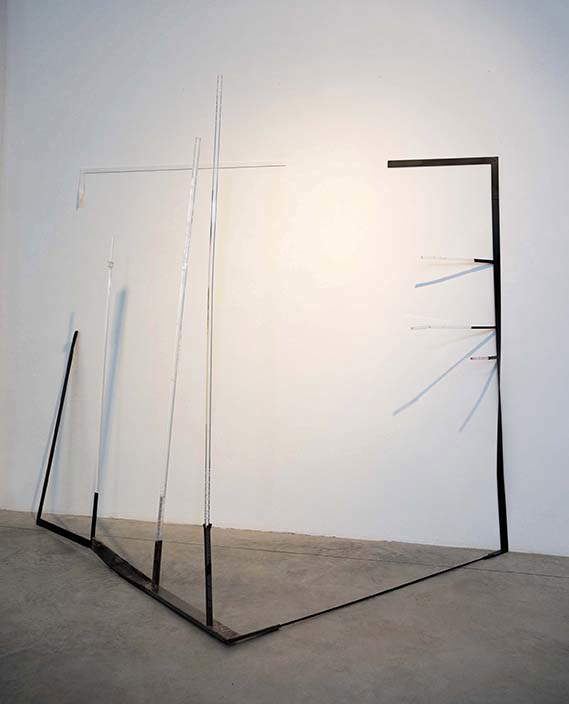

Earlier you mentioned painting as a starting point, can you tell me what kind of work you were doing in your two-dimensional “pre-history”?
Indeed, painting might seem for my current artistic experience “prehistory” as you define it, but in fact it is not really so...I will reveal it to you perhaps in a later step if your wit poses the correct question. Now in answering what you ask, I will tell you that I begin my experience in the visual arts as a painter by experimenting with the various, traditional techniques in which, however, I do not find a response to my expressive vein. I greatly admire painters who use oil, figure, form the translate to informal, matter the collage and so on. Then not to be forgotten is the not insignificant “presence” of my father Osvaldo, an able draughtsman, painter, experimenter, and last but not least the whole entourage of his painter friends whom I saw capable, skilled and with deep admiration. I was never a capable “reproducer,” one skilled at verosimilarity to “representation.” Then as I studied, I realized that one could also do this craft with other skills: expressive ones. Here then I decided to express through figurative works or similar with collage... tragic images of faces painted in collage of paper towels or sheets of scottex soaked in watercolor, chine, ecoline pasted on various supports treated with vinyl glues and redrawn with brush/ink... an almost graphic operation. The encounters in Milan with the informal, the knowledge of Burri, Giaquinto, the area of Giovanni Fumagalli’s Delle Ore gallery and so on allowed my painting to translate beyond the figure and to be fascinated by matter. The surface becomes the theater of multiple actions, articulated at times suffused by various elements. Then the meeting with Patrizia Serra of Spaziotemporaneo and the complex environment of a series of artists present, constituted the turning point in “cleaning up” the surface and concentrating in almost monochromatic or bichromatic ranges made with various materials...with “a painting made no longer by pennicilla” as Rossana Bossaglia writes in her text Il colore dell’ombra (The Color of Shade ) presenting my solo exhibition at the Museo dei Bozzetti in Pietrasanta (1995). In short, painting was and is the springboard for what I have done and still try to do in visual art. It has taught me the sincerity and at the same time the fiction of communicating, just think of the representation of space, the geometric one of the Florentine Renaissance to the spatial one of Rothko’s vibrant planes of color (just to name one I love). The space that is and remains the perennial obsession of painting and beyond (think of Fontana). Here is painting that then is not so two-dimensional.
In fact, chromatic/material traces persist in your current work. Often your works, while hovering in space, arise from the wall. Is this perhaps where the point of contact you mentioned at the beginning of the previous answer lies?
Dear Gabriele, your careful and timely insight partially centers the painting/sculpture problem that has gripped my production since its origins. I try to explain myself better: after the initial all-pictorial-graphic-figurative parenthesis of the beginnings late 1970s-early 1980s where the surface, the support, the drafting, the color, the collage, etc. were the creators of the work, already towards the end (1987-1988-1989) I began to be interested in more material solutions with slight projections from the surface of the support which was not only canvas but, wood, aluminum, always however with a strong and aggressive presence of painting (by then abstract with a gestural-informal flavor) that always maintained an architectural-spatial research framework with the insertion of materials such as copper, lead, iron, stainless steel, all, however, always on the wall within the framework of the so-called two-dimensionality. The 1990s are the all-material development of painting the experimentation with other techniques the sands, tar, papers, wood, fire, metals: here the first important turning point. The frame becomes twofold: the diptych that was previously pictorial with whites and blacks (I have already explained to you in the past my relationship with black) becomes empty, the frame is a rectangle in iron plate with a few elements inserted and the wall that creates the space, the counterbalance the companion in black (full) and the diptych unique work is created. Is it painting? Is it sculpture? The thing does not interest me! It does not limit me and above all it has freed me from the canons by “cleaning up” as I go along what was engulfing and excessive in previous works. 1999 with the exhibition in Milan at Patrizia Serra’s Spaziotemporaneo Gallery curated by Luciano Caramel the further turning point ... unbeknownst to anyone but myself I present works made in a few months (even Patrizia and less so Luciano) expected those works. Flat, iron frames, medium to large sizes, all twisted on the shapes of my body with a few inserts of iron wires, woods with fire-treated paper and graphite dust, Plexiglas scratched and dirtied with iron and graphite dust...all “clinging” to the wall with distortions and irregular projections from 10 to 30 cm, and above all the shadow reiterating the marks in the wall space with natural or artificial light. Here appears the sculptor Valdi? I don’t know. What is certain is that the a previous exhibition (that of the 1996 Diptychs ) already Dorfles, Caramel, Crispolti had guessed what even I had not seen would be my continuation. From there on, the works have increasingly undergone a formal synthesis, a “drying” of elements that are strengthened through the twists of the frames the projection on the wall of their own shadows and the transparency of the Plexiglas treated, salvaged, with signs, colors and traces of their own and created...It is the presence of painting in sculpture! That presence that will become perpetual in form and use of different elements up to the most contemporary works. Already Alberto Veca (2008) in the presentation of my solo exhibition at Galleria Cavenaghi Arte in Milan Asimmetrie - pieghe - torsioni in his text A terra e a parete delineated this constant nature of mine between painting and sculpture and the necessity almost historical on a choice of line sculpture to descend from the wall to the ground or in some cases use the wall support ... a sculpture of mine Architecture on us the sky (2000) is a demonstration of this work among other things usable since it is physically traversable. In conclusion I affirm this diptych nature of mine picto-sculptural, I do not want genre limits, in fact I am also an anomalous sculptor, I draw very little and I almost never plan my works... they are realized work in progress, my Projects for sculpture (the so-called papers), often and willingly follow the realization of the work or they remain just such without the sculptural work resulting. The material-chromatic phase of the work, the one that ideologically “binds” it to painting, is often entrusted to colored and treated Plexiglas or to burnishing and frosting the ferrous material that with the refractions of light reproduces countless chromatic sensations to the eye. A quote almost provocative: I win in 2001 the 1st Prize for Painting of the National Academy of San Luca ìwith the work Ritratto silente 2° of 1998... a wall sculpture enriched only by wooden flap re-lined with fire-treated paper and graphite powder, the rest was an empty iron frame all twisted with iron wires clinging to the wall. That was it.
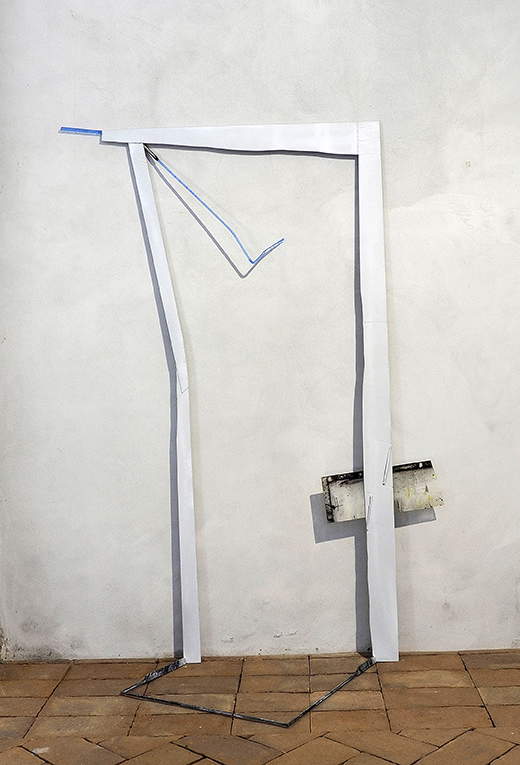
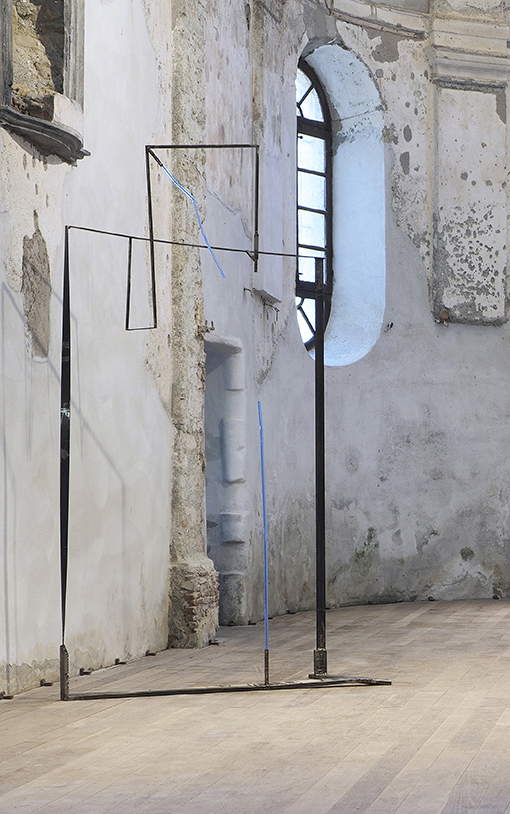







On the mode of operation I wanted to ask you to go into, the first thing that comes to mind is: do you ever destroy, or rather rework, a piece that you thought was finished and actually turns out to be ready to become something else?
Honestly not at all! Rarely, perhaps in my youth when performance anxiety about making “the perfect”, “absolute” work led me to rework that I personally found unnecessary as much as deleterious. I also teach this to my students, in selecting the works made we choose those that most resonate with our feeling at that particular time. What we consider to be “wrong” should be allowed to live in order to perhaps re-evaluate it in retrospect as a stage for further development, or to have a continuous view of it (under the eye) and try not to reiterate those mistakes that, we feel are “unforgivable.” As I have already stated here, my work arises from direct choice in the work in progress... little planning so “error” is often supporting nature of the work itself, so at the appropriate case “Nothing is created, nothing is destroyed, everything is transformed.” The work for me becomes a mutable element. Certainly some fragment or piece that shows itself unpalatable or opportune can become “rubble” that in the future as objets trouvés could have new life or give rise to something else... or not!
Yours is therefore a work marked by instinctuality, in this way of working are the various elements that make up the work calling to each other?
Gabriele, I have often in the past admired artists who design their own works...in this my training as an architect certainly could have helped or misled me...fortunately neither condition. My works have almost always over time sprung from a pretext, from metal that dazzles me, from Plexiglas that reiterates light and shadow in space or, as in some more recent ones, thanks to my sculptor friend Giuliano Ferla who in his carpentry shop made me a gift of sheets and flakes of antique Murano glass, floor sculpture, wall sculpture, and even works on paper have sprung from a piece of transparent or opaque paste colored glass around which I recreated the forms of an object that I felt congenial to it. Here it is that as you say in your question, the various elements seek each other out and lead the eye through space and time...I hope! It’s not really just instinct that drives this process but, it does play a role.
Warning: the translation into English of the original Italian article was created using automatic tools. We undertake to review all articles, but we do not guarantee the total absence of inaccuracies in the translation due to the program. You can find the original by clicking on the ITA button. If you find any mistake,please contact us.